Slovenia
2019
"Mammal Fossils of Slovenia: Anthracotherium Magnum"
| Issue Date |
22.03.2019 |
| ID |
Michel: 1356;
Scott: 1325;
Stanley Gibbons:
Yvert et Tellier: 1138
Category: pF |
| Design |
Edi Berk |
| Emission/Type |
commemorative |
| Place of issue |
Trbovlje |
| Stamps in set |
1 |
| Value |
€0.85 - an Oligocene mammal from the Zasavje region (Anthracotherium magnum) |
| Size (width x height) |
42.60 x 29.82 mm
|
| Layout |
Sheet of 25 stamps |
| Products |
FDC x1 |
| Paper |
Tullis Russell Chancellor Litho PVA
RMS GUM, 102 g/m2
|
| Perforation |
14 x 14 |
| Print Technique |
Offset, 4 colours |
| Printed by |
Agencija za komercijalnu djelatnost
d.o.o., Zagreb,
Croatia
|
| Quantity |
40.000 |
| Issuing Authority |
Posta Slovenije
|
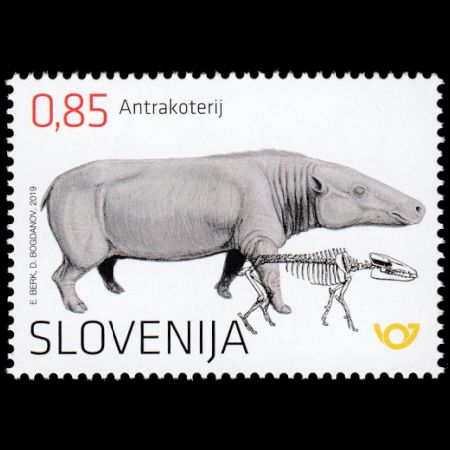
On March 22
nd, 2019, Slovenian Post Authority issued the fourth stamp of their multi-year
set of "
Mammals fossils in Slovenia"
showing fossil and reconstruction of
Anthracotherium Magnum.
The first stamp of the set was issued in
2016 and shows a fossil of a cave bear.
The following text was written by Matija Kriznar MSc,
palaeontologist and senior curator Slovenian Natural History Museum
and was published on the website of Slovenia in 2016.
The anthracothere – an Oligocene mammal from the Zasavje region.
Back in the days when coal mines were still operating
in the Zasavje region, it was not uncommon for miners to dig up fossil remains of various kinds.
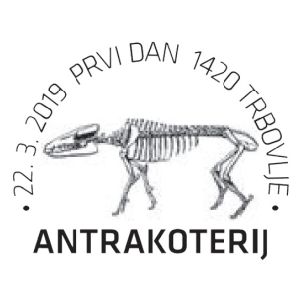
|
|
The skeleton of Anthracotherium magnum on commemorative postmark of Slovenia 2019
|
Particularly noteworthy finds included the remains of large mammals such as the anthracothere.
The genus name of these mammals,
Anthracotherium, translates literally as “coal beast”.
Reports of discoveries of the remains of these creatures were already arriving from open pits and mines in Hrastnik,
Trbovlje and Zagorje ob Savi in the mid-nineteenth century.
Contemporary palaeontologists classified them as the species
Anthracotherium magnum and, in the case of an
exclusively local find, as
Anthracotherium illyricum.
The unearthed remains were often badly damaged and fragmented, with usually only the teeth being
well preserved.
Today many of the remains are found in palaeontological collections in
Austria,
while collections in Slovenia contain relatively little.
The anthracotheres’ habitat consisted of the vast forests and wetland margins that approximately 25
million years ago (the late Oligocene) extended across the area of present-day central and eastern Slovenia.
They fed on the leaves of trees and various wetland plants, and research indicates that they probably spent
a lot of time in the water.
They grew to a length of two metres and reached a weight of 250 kg.
They belong to the group of mammals whose ancestors lived in Asia and which colonised Europe during the Oligocene.
Their bones and teeth have been excavated in other sites around Europe, from
Italy and
Switzerland to
Germany.
Anthracotheres (genus
Anthracotherium) died out in Europe just a few million years after the
formation of the coal deposits in the Zasavje region.

The bottom row of the stamp sheet, with labels under the stamps.
Products and associated philatelic items
| FDC |
First-Day-of-Issue Postmark |
Stamp Sheet |
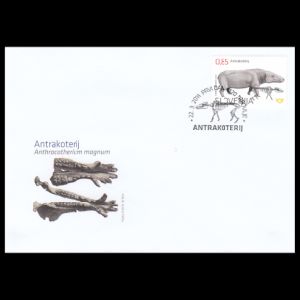 |
 |
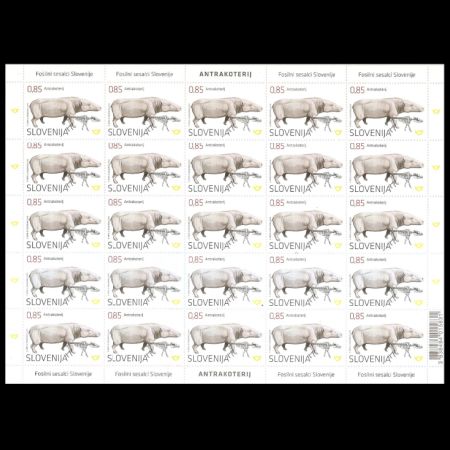 |
|
| Circulated FDC |
|
|
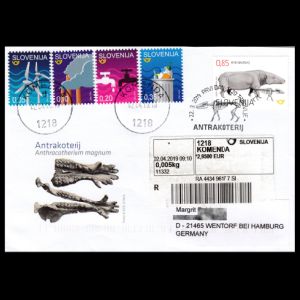 |
|
|
References
Technical details and short description:
Posta Slovenije,
Bulletin Nr. 125
(page 8 with text in Slovenian, German and English languages),
colnect.
Acknowledgements:
Many thanks to
Dr.
Peter Voice from Department of Geological and Environmental Sciences, Western Michigan University,
for reviewing the draft page.







